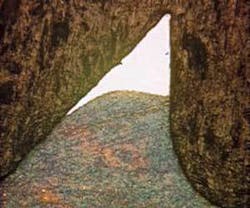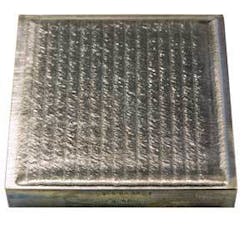With multikilowatt output, the latest direct-diode products are proving to be the optimum solution in several applications
Sri Venkat and John Haake
The demand for high-power direct-diode lasers (HPDDLs) is currently enjoying unprecedented growth, particularly in four key areas: heat treating (surface hardening), cladding, welding, and brazing. At the heart of all solid-state lasers-rod, disk, or fiber-is the pump diode laser, which converts electrical power into optical power. In theory, using the diode output directly for materials processing could reduce laser complexity and be advantageous from a cost and size viewpoint. However, in the past diode lasers could not deliver the same powers or power densities as workhorse industrial lasers such as CO2 and Nd:YAG. Fortunately, there have been advances in several areas of direct-diode technology, including basic semiconductor technology itself, packaging techniques, optical systems, and advanced water-cooling schemes.
The simplest diode laser is called a single emitter, producing laser light from a single tiny output facet. It is used in CD/DVD players and telecom applications and for pumping very-low-power lasers. The next level of complexity is the diode laser bar-a linear array of up to 50 diode-laser emitters created monolithically. Higher power is achieved by stacking these bars to form a two-dimensional array or stack. With bars and arrays the output can be reimaged, reshaped, and focused by conventional optics or by coupling the output into a fiber or fiber bundle. There are now several industrial applications for both optical formats. Moreover, in commercial products, the output of more than one stack can be readily combined with these optics.
In terms of power levels, single-diode-bar powers have now reached 100 W, enabling the construction of multikilowatt arrays. Current lasers also deliver much higher brightness than their predecessors, and focused spots from commercial systems can now reach power densities in the 800-kW/cm2 range. In addition, these high-power devices can be directly modulated at speeds up to 10 kHz, simplifying control over process parameters. This level of brightness is more than sufficient for several metal processing applications.
At the same time, demanding telecom, laser pumping, and military applications have spurred tremendous improvements in lifetime and reliability, bringing the typical lifetime of a multikilowatt diode system to 20,000 hours. As a result, DDLs now offer the smallest package and highest power/cost ratio of any laser type, with sufficient output power and power density to perform a number of common industrial tasks at economical speeds.
Heat treating
In heat treating (case hardening), the goal is to transform a thin outer layer of metal to produce a hard-wearing, long-life surface, without introducing physical distortion or negatively impacting any of the desirable properties of the bulk metal, such as flexibility or stiffness. The current list of applications for DDL case hardening is long and impressive. It includes bearing surfaces, cutting surfaces, pump parts, valve seats and sealing surfaces, drive train components, gears and cams, forming tools, stamping dies, turbine blades, and even hand tools such as needles.
FIGURE 1. Image of a saw blade tooth shows how a DDL system can be used to deliver extremely precise spatial selectivity.
The reason for this success is that DDLs offer a number of distinct advantages over other technologies for case hardening. Because most metals have a high absorption coefficient at 805 nm, thermal penetration is confined to a shallow surface layer, minimizing the possibility of distortion. This also enables the thickness of the case to be controlled by simply varying the laser power and/or the scan rate of the focused beam across the part. The lateral extent of the hardening effect is limited to the area defined by the laser spot. The shallow penetration of the light means there is virtually no distortion, even with thin parts (see Figure 1).
Moreover, the body of the part itself acts as a natural heat sink, eliminating the need for active quenching. The high absorption also avoids the need for absorptive coatings as used with other laser wavelengths. In addition, it makes the process very forgiving with respect to surface contaminants. In terms of end result, DDLs can easily achieve very high hardness (more than Rc 60) without cracking or spalling.
We have analyzed several metals following DDL surface treatment (see table). As a general rule, for a given metal a thicker case requires greater heating, which is achieved by decreasing the scan rate. However, the extra heat slows the quenching rate which in turn determines the case hardness-so thicker cases are often less hard, which is somewhat counterintuitive.
Surface cladding
In cladding, the laser melts a powdered metal placed on the work surface to produce a well-adhered, thick continuous layer. In true cladding the goal is to melt the cladding material with minimal mixing with the substrate metal; for traditional cladding processes, cladding is defined as a process with less than 10 percent dilution of the cladding metal. For laser cladding, results are much better and dilution is limited to only a few percent or even less.
The DDL is displacing conventional (solid-state and CO2) lasers in cladding applications in part again because of the high absorption of the 805-nm wavelength as compared to CO2 laser wavelength of 10600 nm. Specifically, this shorter wavelength (higher photon energies) has increased absorption on all metal surfaces. As a result, the diode laser has been documented to be almost twice as efficient as a CO2 laser in melting metal powder. This high absorption makes even wire-feed cladding easy to implement. This benefit is in addition to the electrical efficiencies, which are four to six times that of CO2 lasers. Therefore, there is a 10X-12X advantage for DDLs over CO2 lasers.
Moreover, the natural rectangular cross section of the diode-laser-bar/array output can be easily reimaged as a line of laser light that is well suited to large-area processing; the line rapidly “paints” across the surface as it is scanned in a direction perpendicular to its long axis. This allows one to achieve thin, wide, and flat cladding with low dilution. But very importantly, overlapping passes wet together well to deliver a relatively flat surface profile, regardless of processing speed (see Figure 2).
Welding
High near-infrared absorption also enables DDLs to be used to weld a variety of metals in true conduction mode with controlled penetration. And once again the line-shaped beam is an ideal shape for continuous seam welding, as commonly used in tube mills, for example. In contrast, older processes such as gas tungsten arc welding (GTAW) and conventional laser welding techniques use a round heating spot.
The DDL projected line geometry is superior because it allows for a longer interaction time at the seam, yet the resulting weld pool is confined to the seam only. Plus, this narrow line geometry permits deeper penetration, allowing molten metal to wet together in a very controllable fashion. This yields a conduction mode weld similar to those produced by a GTAW process, with no spatter. However there is less sagging and a much narrower heat-affected zone (HAZ), which results in improved mechanical properties such as fatigue strength and formability.
FIGURE 3. DDL welding of tubular steel is characterized by high and uniform hardness; this plot shows hardness versus distance across the weld for a 304 stainless steel tube.
A Coherent 4-kW DDL was recently installed on a GTAW-configured tube mill to weld 0.035-inch and 3/8-inch diameter tubing. Importantly, this laser head is small enough to fit within the profile of the existing tube mill without major retrofits, and the beam size is such that no seam tracking devices are required. Welds produced with this setup exhibit exceptionally smooth surfaces on both sides and low distortion, which is consistent with the small HAZ. There is also little oxidation on the surface as a result of the good coverage by the shielding gas.
Maximum hardening and maximum case depth for a variety of metals heat treated with DDL systems.
In addition, the resulting weld and HAZ are approximately three to four times smaller than those resulting from GTAW. Detailed metallographic inspection of welds made with this system reveal a minimal variation in hardness in the HAZ and fusion zone, relative to the base metal (see Figure 3).
Other applications already using DDLs include aluminum welding, pure titanium welding, and welding of zinc-coated steels. DDLs are an ideal laser source for welding galvanized steels because the line profile acts to preheat and vaporize the zinc such that there is no zinc present at the weld pool. This results in an excellent ductile weld. In contrast, systems that use a circular heat profile typically create a plasma plume that can act to trap zinc in the weld pool.
Brazing
Brazing is a process, closely related to welding, that is often used to join galvanized steels for body-in-white applications in the automotive industry. In brazing, two metal edges are joined by melting a different metal placed between them, typically introduced as a wire. Brazing is preferred to welding in automotive applications because welding galvanized steels typically leaves the weld area exposed to corrosion.
Brazing is now one of the fastest-growing applications for DDLs, because of several key advantages compared to traditional techniques based on electrical arc welding-tungsten inert gas (TIG) and metal inert gas (MIG). Automotive applications, in particular, benefit from the high reliability of today’s diode lasers. A complete system often includes multiple stacks with built-in redundancy. When one of the stacks reaches the end of its useful lifetime, the system controller can immediately compensate, greatly reducing downtime.
As with welding, the line spot profile is well suited to the linear geometry associated with continuous wire feed. This simplifies process alignment, in many cases eliminating the need for expensive vision systems. In addition, the line profile serves to thoroughly “wet out” the weld, yielding excellent weld bead profiles. Depending on the weld geometry and the steel thickness, it can also be advantageous to use a square beam profile rather than a line. Again, this is easy to generate from a diode stack using beam-shaping optics.
There are several other advantages of direct-diode brazing, including significantly reduced spatter (compared to MIG), lower heat input with minimized thermal distortion and HAZ and faster throughput (up to 200 percent faster than TIG/MIG depending on part thickness). For example, process speeds of 5 m/min for galvanized steel with silicon-bronze wire are possible when using a 4-kW direct diode system. In addition, the narrow, well-defined nugget means that the seams are much smoother than typical MIG/TIG seams and do not need rework after brazing.
Direct diodes and their applications have advanced significantly from early low-power/low-reliability systems used in a few plastics applications. As both the power and brightness of DDLs continue to increase, their performance/cost advantages will grow, spurring not only further growth in existing DDL applications but also enabling new applications that currently use other laser types or traditional non-laser technologies.
Sri Venkat ([email protected]) and John Haake ([email protected]) are both with Coherent (www.coherent.com).



